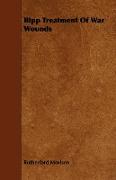- Start
- Bipp Treatment of War Wounds
Bipp Treatment of War Wounds
Angebote / Angebote:
PREFACE WAR has taught surgeons once more the value of Lord Listers work on the use of antiseptics in Wound Treatment, and now it has been proved that with their aid primary union after suture of infected, suppurating wounds is possible. A long surgical experience may be of the greatest value, but in my case it was a handicap, for it took me a long time to realise the truth of what I saw -so opposed was it to all ordinary surgical canons. This small book has been written by request as a War contribution, and in it I have endeavoured to avoid two dificulties which I feared. The first concerned an explanation of our results which I knew would plunge me into ventures from which I could v- not escape unscathed the second was to avoid any over-estimation, from excess of enthusiasm, of the value of this method of wound treatment. The best manner of accomplishing these ends seemed to be by limiting the informa- tion offered to what I knew, and by rejecting ally other matter, however interesting it might be. The book is an account of our net hod of Wound Treatment, and it is so simple that a clever surgeon is unnecessary for the achieve- ment of the best results, though a careful one is essential treatment during the last twenty years had reached such perfection that surgeons had almost concluded that thev were masters of the situation when the War came and awakened them to reality. Many then expressed the view that War wounds were as bad as those of fifty years before, but that was because few had actual experience of so long ago. The War wounds were bad enough-painful , incapacitating, healing slowly and with large indurated scars, but, however ill they made their victim, seldom deadly those of fifty years ago, especially when involving bones, terminated as often in death from septic infection as in recovery-a difference of vital importance. The explanation is simple. Our War wounds, after treatment was instituted, were spared further infection from outside the wounds of fifty years ago were infected anew after every surgical manipulation. We wash our hands before operations, the older surgeons washed theirs after the operation was over. The first year of the War was one of unhappy surgical experience. Though the mortality in home hospitals was very small, everyone soon learned that free drainage and frequent dressings were the only safe measures, and that beyond these the Iess done to the wounded the better they recovered. Any opening up of fresh surfaces was likely to be followed by local and general signs of inflammation, such as increased suppuration and fever, and the most unpromising looking conditions were often left alone because of 4 9 the fear of a septic flare-up , after any surgical interference. Towards the end of the year 1915, heartened by the results of this treatment, I gradually developed a new method of dealing with infected wounds, which has been proved efficient. Though not yet ideal in results, it is more nearly so than any other so far evolved. My conclusion now is That if it is possible to get to the bottom of an infected womd so that it can be thoroughly cleansed mechanically, and suitable antiseptics be applied, the wotrnd can be closed at once with interreipted sttures, always with impunity, and many times with the prospect of Jilding it healed when the dressing is removed for the first time at the end of three weeks. This fact has been proved by hundreds of cases and establishes a new Principle in Surgery, though details of the method can doubtless be improved. For example, in our early cases pure carbolic acid was used as an important adjunct...
Folgt in ca. 10 Arbeitstagen
